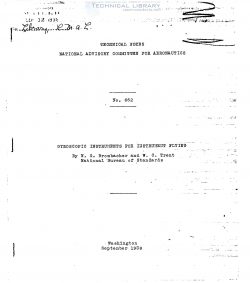naca-tn-662
- Version
- 134 Downloads
- 2.29 MB File Size
- 1 File Count
- November 28, 2016 Create Date
- November 28, 2016 Last Updated
National Advisory Committee for Aeronautics, Technical Notes - Gyroscopic Instruments for Instrument Flying

The gyroscopic instruments commonly used in instru—
ment flying.in the United States are the turn indicator,
the directional gyro, the gyromagnetic compass,‘the gyro~
scopic horizon, and the automatic pilot. These'instruE
ments are described. Performance data and the method of
testing in the laboratory are given for the turn indi-
cator, the directional gyro, and the gyroscopic horizon.
Apparatus for driving the instruments is discussed.
When the ground is not visible the navigation of air-
craft depends solely upon instruments. Progress in in—
strument flying, as this type of navigation is called,
rests largely upon the development of satisfactory iistru~"
ments for maintaining straight, level flight, the propef
course, and a safe altitude. It was discovered early that
the indications of the magnetic compass and inclinoneters
of the gravity—controlled type could not be relied upon to
maintain an airplane in straight, level flight due largely'
to the effects of acceleration of the aircraft. It soon
became evident that the ultimate basis for satisfactory
instruments is the gyroscope. The magnetic compass was“
found to be unreliable during turns from a northerly or
southerly course, and unsteady in indication in bumpy air.
Inclinometers of the type early available such as pendu~
lums, rolling balls, or bubble levels, indicate accelera-
tions as well as inclination, with no available means to
differentiate between the two.
The gyroscopic instrument first used generally was the
gyroscopic turn indicator developed in 1918 and 1919 (ref—
erences l and 2). In this instrument a precession_of the
rotor is produced only by turning the instrument about its—
vertical axis. The precessional torque is balanced by a
spring. The turn indicator is used principally to differ~
entiate between the conditions of straight flight and
turning.
Attempts have been made to control the rotor speed of
turn indicators in order to secure accurate indications of
the rate of turn. Control of the speed of air-driven ro—
tors requires a speed—measuring device or a device for
measurement or control of volume air flow, both inconven-
ient on aircraft. The most practical solution would be
the use of an electrically driven rotor, such as have been
developed and are in limited use, mainly in.research work
(N. A. C. A. in this country) and on rigid airships. Their
use in airplanes has-been rendered almost needless by
other developments.
| File | Action |
|---|---|
| naca-tn-662 Gyroscopic Instruments for Instrument Flying.pdf | Download |

Comment On This Post